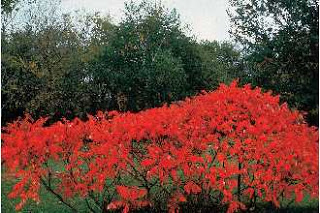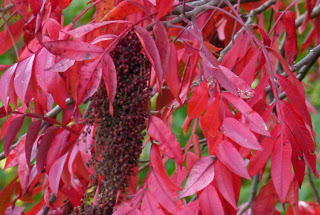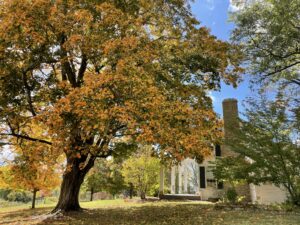We all enjoy the bright colors of fall. Sometimes I can’t find enough adjectives to describe the reds of maple trees and dogwoods. But the brightest red of all may be the sumac. Sumac is a shrub or small tree, native to most of North America, although it is considered a nuisance in some places.
A variety known as Staghorn Sumac has smooth branches likened to the velvet on a deer’s antlers – thus the name Staghorn. There are other varieties, which I couldn’t pin down with much confidence. Look closely on the stems in this photo. See the small wings? I think it may be the Winged Sumac.
The fruit grows in large clusters of red berries called “drupes”. (Where in the world do they get these names?) These acidic and tart berries can be eaten raw or dried, though they’re most popularly used in the form of a berry tea or beverage termed “sumac-ade,” “Indian lemonade” or “rhus juice”. This drink is made by soaking the drupes in cool water, rubbing them to extract the essence, straining the liquid through a cotton cloth and sweetening it. Native Americans also used the leaves and drupes of the Smooth and Staghorn Sumacs combined with tobacco in traditional smoking mixtures, and for many medicinal purposes. Sumac grows in other parts of the world as well. The fruits of the genus Rhus are ground into a deep-red or purple powder used as a spice in Middle Eastern cuisine to add a lemony taste to salads or meat. In Arab cuisine, it is used as a garnish on meze dishes such as hummus and is added to salads in the Levant. In Iranian (Persian and Kurdish) cuisine, sumac is added to rice or kebab.
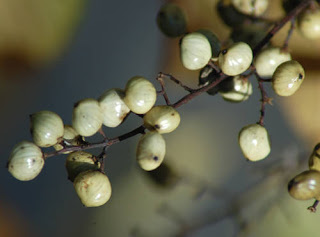 |
| Poison Sumac Berries |
When most people hear the word sumac, they automatically think “poison sumac.” Indeed one kind is related to poison ivy, and touching any part of it can induce a terrible rash. You can tell the good from the poison version by the berries. Poison sumac has white berries. Of course that doesn’t help during the rest of the year, does it?
 |
| Ailanthus or Tree of Heaven |
Sumac also bears a resemblance to the Ailanthus, or Tree of Heaven, which is definitely an invasive non-native plant. Both have compound leaves, but Ailanthus turns yellow and tan in the fall; staghorn sumac turns red, ranging into purples and oranges. The two plants have completely different fruit however. Both have greenish flowers at the branch tips. The Ailanthus’ come in whitish-green foamy plumes and the male flowers stink. The staghorn sumac’s flowers come in tight lime green pyramids. Ailanthus flowers mature, on the female plants only, into gold clusters of winged seeds tinged with rust (aging to light tan); staghorn sumac has fuzzy berries that go from lime to deep red.
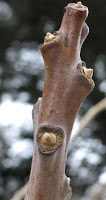 |
| Staghorn Sumac |
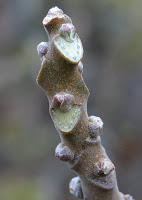 |
| Ailanthus |
Believe it or not, comparing the leaf scars and buds points out the most interesting difference between these two trees and a few others. Ailanthus leaf scars are smile- or shield-shaped with the new bud at the top of the scar; staghorn sumac leaf scars are closer to heart-shaped and, amazingly, the new bud is right in the center of the old scar! The sumac buds are usually hairy if you look closely enough.

